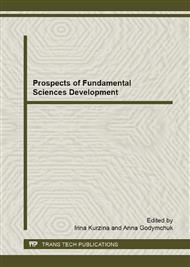[1]
G.A. Volozhin, Basic types of biocompatible materials, MSMSU Press, Moscow, (2010).
Google Scholar
[2]
S.V. Sheremetev, E.M. Shteynberg, Application of functional polymers in medicine, SibAK Press, Kazan, (2012).
Google Scholar
[3]
M. Bryjak, I. Gancarz, G. Pozniak, Plasma-modified porous membranes, Chem. Pap. 54(6b) (2000) 496-501.
Google Scholar
[4]
T.D. Tran, S. Mori, M. Suzuki, Plasma modification of polyacrylonitrile ultrafiltration membrane, Thin Sol. Films. 515 (2007) 4148–4152.
DOI: 10.1016/j.tsf.2006.02.045
Google Scholar
[5]
E.F. Castro Vidaurre, C.A. Achete, F. Gallo, D. Garcia, R. Simao, A.C. Habert, Surface modification of polymeric materials by plasma treatment, Mat. Res. 5 (2002) 37–41.
DOI: 10.1590/s1516-14392002000100006
Google Scholar
[6]
M.A. Deminsky, V. Chorkov, G. Belov, Chemical Workbench – integrated environment for materials science, Comp. Mat. Sci. 28 (2003) 169–178.
DOI: 10.1016/s0927-0256(03)00105-8
Google Scholar
[7]
M. Strobel, C.S. Lyons, K.L. Mittal, Plasma Surface Modification of Polymers. Relevance to Adhesion, VSP BV, Netherlands, (1984).
Google Scholar
[8]
I.G. Kuznetsova, S.E. Severin, Application of lactic and glicolic acid sopolymers to obtain nanosized dosage forms, Drug Development Registration, Res. Prod. J. 5 (2013) 30–38.
Google Scholar
[9]
M-E. Vlachopoulou, A. Tserepi, A low temperature surface modification assisted method for bonding plastic substrates, J. Micromech. Microeng. 19 (2009) 015007–015013.
DOI: 10.1088/0960-1317/19/1/015007
Google Scholar
[10]
M.A. Efremov, V.I. Svettsov, V.V. Rybkin, Vacuum plasma processes and techniques, Ivanov State Chem. -Tech. Univ. Press (in Russian), Ivanov, (2006).
Google Scholar
[11]
M.V. Zhuravlev, M.S. Slobodyan, B.G. Shubin, System for atmosphere hf volume discharge, Rus. Phys. J. 55, 456–458.
Google Scholar
[12]
EasyDrop Contact Angle Measuring Instrument: Doubly simple, KRUSS Technical information, (2006).
Google Scholar
[13]
D.K. Owens, R.C. Wendt, Estimation of the surface free energy of polymers, J. Appl. Polym. Sci. 13 (1969) 1741–1747.
DOI: 10.1002/app.1969.070130815
Google Scholar
[14]
V.V. Kolesnichenko, D.N. Trofimov, Fluoropolymer covers. Experience and prospects of applying, Collection of scientific papers, RSC «Applied Chemistry», St. Petersburg, (2009).
Google Scholar
[15]
Yu.P. Raizer, Gas discharge physics, Intellekt Publ., Moscow, (2009).
Google Scholar
[16]
N.A. Yavorovskiy, Ya.I. Kornev, S.V. Preis, Pulse barrier discharge as a method of water treatment: active oxidizer particles in waterair flow, Bull. of Tomsk Polytech. Univ. 309 (2006) 108–112.
Google Scholar
[17]
I.A. Grishina, V.A. Ivanov, L.M. Kovrizhnykh, Plasma physics and plasma methods, Succ. of Appl. Phys. 1 (2013) 415–438.
Google Scholar
[18]
S.A. Golovyatinskiy, Modification of polymeric surface by pulse plasma of atmospheric pressure, Vestn. Hkarkov. Univ. 24 (2004) 80–86.
Google Scholar


